The November meeting talk was given by Jeremy Batch who is a regular presenter at our meetings. The meeting at the RNA in Welwyn Garden City was well attended but also had a Zoom audience listening in as well. This format which was a trial for an external speaker was very successful and will be continued at future meetings especially during the winter months.

He had previously presented
Apr 2017. The Story of Navigation
Sep 2018. Waves, Wheels & Sparks: Sailing into the Electrical Age
Oct 2019: Allo, Allo: the Story of Communications
Nov 2020: Making Space for Sailing part 1 (on ZOOM)
Oct 2021: Making Space for Sailing part 2 (on ZOOM)
Nov 2022: Going Boldly: across, beneath and beyond the Ocean
The theme of the Talk in November was Sailing into the Electronic Age
Sailing into the Electronic Age
A Synopsis of the meeting provided by Jeremy Batch is shown below.

“We have no use for these inventions” was the rebuff given to Christian Hülsmeyer by Telefunken in 1905 when he offered them his early versions of radar and the chart plotter. Decca would make the same mistake with the Beatles. In this sequel to “Sailing into the Electrical Age” (presented to SOCA in September 2018 ) we’ll follow the adventures and misadventures of the inventors, scientists and engineers who brought us not only radio and radar but all the other gadgets we never knew we wanted on our vessels and in our homes. We’ll start with a long-delayed visit to Cragside, William Armstrong’s home in Northumberland, to admire his (British!) light bulbs from Joseph Swan, powered hydroelectrically in 1881 from a convenient lake via a generator from Werner Siemens. We’ll look at the radio valve, the cathode ray tube (once in your TV and radar) and the cavity magnetron (still in your microwave and probably your radar) and move on down to the transistor, the integrated circuit, the microprocessor and the memory chip, now allowing you to drop the entire Admiralty chart collection into your plotter or into the bilges — provided you can still get the chips. Also: a return visit to London’s Lea Valley where the British electronics industry was nurtured, a wartime miniature radar device whose level of secrecy approached that surrounding the Flag Officers’ Lunch, and “the machines that made nothing” but made everything possible.
